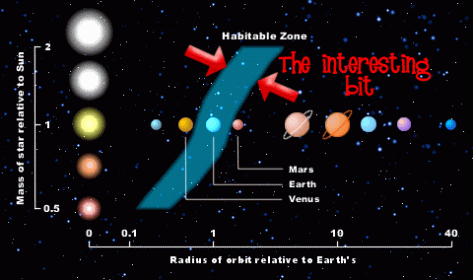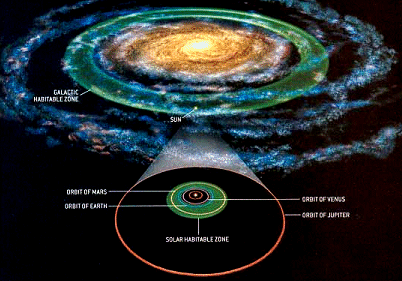
Some atheists who don’t understand the fine-tuning argument like to assert that the constants and quantities that are fine-tuned to allow for the existence of complex, embodied life can be changed arbitrarily, and life would still exist as it does now. They say that maybe we would have a ridges in our foreheads like Klingons, or maybe we would have longer ears like Vulcans or maybe green skin like Orions. The evidential support for this view seems to be grounded in Star Trek TV shows, not peer-reviewed evidence. Are atheists right to ground their rejection of a cosmic Designer in science fiction television shows? What does the peer-reviewed research say?
The fine-tuning argument
First, let’s review the structure of the fine-tuning argument.
The argument goes like this:
- The fine-tuning of the universe to support life is either due to law, chance or design
- It is not due to law or chance
- Therefore, the fine-tuning is due to design
Although each permutation of values for the constants and quantities is equally improbable, the vast majority of the permutations will not permit life.
Let’s review:
- Life has certain minimal requirements; long-term stable source of energy, a large number of different chemical elements, an element that can serve as a hub for joining together other elements into compounds, a universal solvent, etc.
- In order to meet these minimal requirements, the physical constants, (such as the gravitational constant), and the ratios between physical constants, need to be withing a narrow range of values in order to support the minimal requirements for life of any kind.
- Slight changes to any of the physical constants, or to the ratios between the constants, will result in a universe inhospitable to life.
- The range of possible values spans 70 orders of magnitude.
- The constants are selected by whoever creates the universe. They are not determined by physical laws. And the extreme probabilities involved required put the fine-tuning beyond the reach of chance.
- Although each individual selection of constants and ratios is as unlikely as any other selection, the vast majority of these possibilities do not support the minimal requirements of life of any kind. (In the same way as any hand of 5 cards that is dealt is as likely as any other, but you are overwhelmingly likely NOT to get a royal flush. In our case, a royal flush is a life-permitting universe).
Now let’s see a specific example: carbon and oxygen formation.
Carbon is that element that can serve as a hub for larger molecules, and oxygen is also a vital element, since it is a component of water, which is required for life (universal solvent). Both are required for complex life of any imaginable kind.
Now for the study.
Here is an article on Science Daily about the fine-tuning argument.
It says:
Life as we know it is based upon the elements of carbon and oxygen. Now a team of physicists, including one from North Carolina State University, is looking at the conditions necessary to the formation of those two elements in the universe. They’ve found that when it comes to supporting life, the universe leaves very little margin for error.
Both carbon and oxygen are produced when helium burns inside of giant red stars. Carbon-12, an essential element we’re all made of, can only form when three alpha particles, or helium-4 nuclei, combine in a very specific way. The key to formation is an excited state of carbon-12 known as the Hoyle state, and it has a very specific energy — measured at 379 keV (or 379,000 electron volts) above the energy of three alpha particles. Oxygen is produced by the combination of another alpha particle and carbon.
NC State physicist Dean Lee and German colleagues Evgeny Epelbaum, Hermann Krebs, Timo Laehde and Ulf-G. Meissner had previously confirmed the existence and structure of the Hoyle state with a numerical lattice that allowed the researchers to simulate how protons and neutrons interact. These protons and neutrons are made up of elementary particles called quarks. The light quark mass is one of the fundamental parameters of nature, and this mass affects particles’ energies.
In new lattice calculations done at the Juelich Supercomputer Centre the physicists found that just a slight variation in the light quark mass will change the energy of the Hoyle state, and this in turn would affect the production of carbon and oxygen in such a way that life as we know it wouldn’t exist.
[…]The researchers’ findings appear in Physical Review Letters.
There are many, many other examples of fine-tuning of the constants and quantities to permit complex, embodied life. And, as we’ll see below, this evidence is admitted by atheists.
Atheists agree: the fine-tuning is a fact
Let me give you a citation from the best one of all, Martin Rees. Martin Rees is an atheist and a qualified astronomer. He wrote a book called “Just Six Numbers: The Deep Forces That Shape The Universe”, (Basic Books: 2001). In it, he discusses 6 numbers that need to be fine-tuned in order to have a life-permitting universe.
In chapter 1, Rees writes:
Mathematical laws underpin the fabric of our universe — not just atoms, but galaxies, stars and people. The properties of atoms — their sizes and masses, how many different kinds there are, and the forces linking them together — determine the chemistry of our everyday world. The very existence of atoms depends on forces and particles deep inside them. The objects that astronomers study — planets, stars and galaxies — are controlled by the force of gravity. And everything takes place in the arena of an expanding universe, whose properties were imprinted into it at the time of the initial Big Bang.
[…]This book describes six numbers that now seem especially significant.
[…]Perhaps there are some connections between these numbers. At the moment, however, we cannot predict any one of them from the values of the others.
[…]These six numbers constitute a ‘recipe’ for a universe. Moreover, the outcome is sensitive to their values: if any one of them were to be ‘untuned’, there would be no stars and no life. Is this tuning just a brute fact, a coincidence? Or is it the providence of a benign Creator?
There are some atheists who deny the fine-tuning, but these atheists are in firm opposition to the progress of science. The more science has progressed, the more constants, ratios and quantities we have discovered that need to be fine-tuned. Science is going in a theistic direction. Next, let’s see how atheists try to account for the fine-tuning.
Atheistic responses to the fine-tuning evidence
There are two common responses among atheists to this argument.
The first is to speculate that there are actually an infinite number of other universes that are not fine-tuned, (i.e. – the gambler’s fallacy). All these other universes don’t support life. We just happen to be in the one universe is fine-tuned for life. The problem is that there is no way of directly observing these other universes and no independent evidence that they exist.
Here is an excerpt from an article in Discover magazine, (which is hostile to theism and Christianity).
Short of invoking a benevolent creator, many physicists see only one possible explanation: Our universe may be but one of perhaps infinitely many universes in an inconceivably vast multiverse. Most of those universes are barren, but some, like ours, have conditions suitable for life.
The idea is controversial. Critics say it doesn’t even qualify as a scientific theory because the existence of other universes cannot be proved or disproved. Advocates argue that, like it or not, the multiverse may well be the only viable nonreligious explanation for what is often called the “fine-tuning problem”—the baffling observation that the laws of the universe seem custom-tailored to favor the emergence of life.
The second response by atheists is that the human observers that exist today, 14 billion years after the universe was created out of nothing, actually caused the fine-tuning by going back in time and causing the universe to be fine-tuned. This solution would mean that although humans did not exist at the time the of the big bang, they are going to be able to reach back in time at some point in the future and manually fine-tune the universe.
Here is an excerpt from and article in the New Scientist, (which is hostile to theism and Christianity).
…maybe we should approach cosmic fine-tuning not as a problem but as a clue. Perhaps it is evidence that we somehow endow the universe with certain features by the mere act of observation… observers are creating the universe and its entire history right now. If we in some sense create the universe, it is not surprising that the universe is well suited to us.
So, there are two choices for atheists. Either an infinite number of unobservable universes that are not fine-tuned, or humans go back in time at some future point and fine-tune the beginning of the universe, billions of years in the past. I think I will prefer the design explanation to those alternatives.
Positive arguments for Christian theism
- The kalam cosmological argument and the Big Bang theory
- The fine-tuning argument from cosmological constants and quantities
- The origin of life, part 1 of 2: the building blocks of life
- The origin of life, part 2 of 2: biological information
- The sudden origin of phyla in the Cambrian explosion
- Galactic habitable zones and circumstellar habitable zones
- Irreducible complexity in molecular machines
- The creative limits of natural selection and random mutation
- Angus Menuge’s ontological argument from reason
- Alvin Plantinga’s epistemological argument from reason
- William Lane Craig’s moral argument
- The unexpected applicability of mathematics to nature
- Arguments and scientific evidence for non-physical minds



